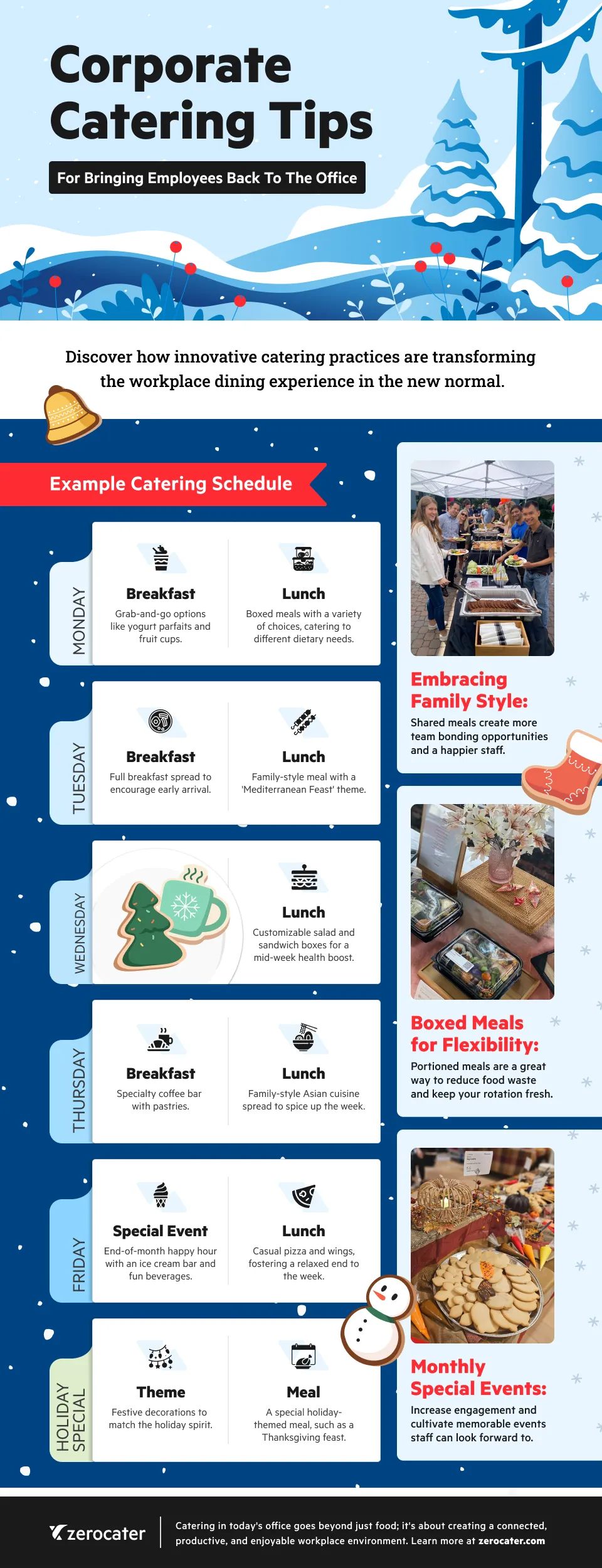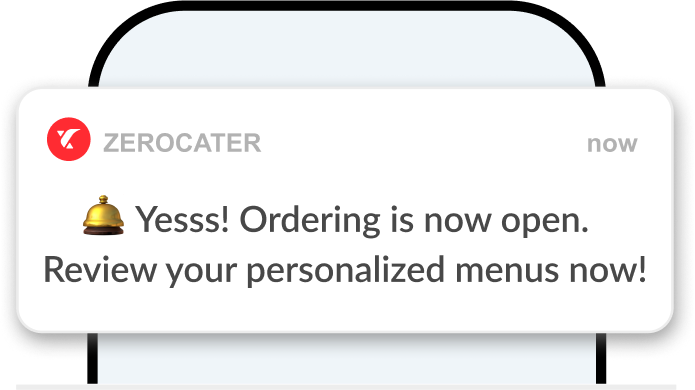As the world adapts to the new normal and offices gradually reopen, there’s a fresh buzz around corporate catering. Gone are the days of one-size-fits-all meal plans; today’s workplace demands flexibility, creativity, and a keen understanding of employees’ evolving needs. From the allure of themed meals to the practicalities of fluctuating headcounts and budgets, the culinary landscape within the corporate world is undergoing a significant transformation. We aim to highlight the best practices for corporate catering, and spotlight how companies can effectively entice their workforce back to the office with enticing and thoughtful meal programs.
Embracing Family Style
In the heart of every thriving office lies a place where colleagues gather not just to eat, but to connect – the cafeteria. To rekindle this communal spirit, especially on high-traffic days like Tuesdays and Thursdays, embracing a family-style meal approach has proven effective. These are not just lunches; they are experiences designed to break the ice and strengthen bonds. The family-style setup encourages sharing, conversation, and a sense of belonging, vital in reinforcing the office community. Adding themed decorations and special menus for occasions like seasonal holidays or company milestones elevates these gatherings, making them memorable events rather than mere lunch breaks.
Boxed Meals for Flexibility
In today’s dynamic work environment, flexibility is key. For the less crowded days of the workweek, the convenience and efficiency of boxed meals come to the fore. These pre-packaged, individually portioned meals cater to the diverse preferences and schedules of employees. Whether it’s a grab-and-go breakfast or a lunch option, the ability to pre-select meals minimizes waste and ensures that every team member has access to nourishing, personalized food options. This approach aligns perfectly with the unpredictable nature of office attendance in a post-pandemic world.
Monthly Special Events
Once a month (or more!), the ordinary office day transforms into something extraordinary. Companies are increasingly hosting special events like happy hours, themed dinners, or interactive culinary experiences. Aligning these with all-hands meetings or significant corporate dates, these events serve as a beacon, drawing employees back into the office. Options like Boba Tea afternoons, ice cream bars, or sophisticated hors d’oeuvres and cocktails not only provide a break from the routine but also offer a platform for casual networking and team-building. Aligning these with holidays throughout the year such as Cinco De Mayo, Independence Day, and Halloween is a no-brainer and can provide for a ca n’t-miss reason for employees to come into the office.
Breakfast – The New Frontier
The early bird doesn’t just catch the worm; in modern offices, it catches a delightful breakfast. Recognizing the potential of the morning hours, companies are now introducing breakfast on family-style meal days. This approach has multiple benefits: it encourages early office arrival, fosters a productive start to the day, and avoids the dreaded ‘coffee badge’ scenario where quick coffees replace meaningful interaction. From healthy smoothies to hearty traditional fare, these breakfasts are becoming a popular trend, setting a positive tone for the day ahead.
Executive Dining: Quarterly Indulgences
Every quarter, the boardroom transforms into a gourmet dining hall. These high-end, meticulously planned events are tailored for executive meetings, offering an elevated catering experience. The focus here is on premium quality, with high-end menus featuring the finest ingredients, often paired with exceptional wines and spirits.
Smart Subsidy Strategies
Innovative subsidy strategies play a crucial role in companies where fully subsidized meals aren’t the norm. By providing employees with a ‘meal wallet’ or a daily subsidy cap, companies can offer the benefits of a catered meal program while managing costs effectively. This approach empowers employees to choose when and what they eat, within the company’s budget constraints. It’s a balanced solution that respects personal choice and dietary needs while maintaining fiscal responsibility.
Crafting The Ideal Return To Office Week With Catering
To bring these practices to life, let’s visualize an example of an ideal corporate catering week:
Monday:
- Breakfast: Grab-and-go options like yogurt parfaits and fruit cups.
- Lunch: Boxed meals with a variety of choices, catering to different dietary needs.
Tuesday (High Headcount Day):
- Breakfast: Full breakfast spread to encourage early arrival.
- Lunch: Family-style meal with a ‘Mediterranean Feast’ theme.
Wednesday:
- Lunch: Customizable salad and sandwich boxes for a mid-week health boost.
Thursday (High Headcount Day):
- Breakfast: Specialty coffee bar with pastries.
- Lunch: Family-style Asian cuisine spread to spice up the week.
Friday:
- Lunch: Casual pizza and wings, fostering a relaxed end to the week.
- Special Event: End-of-month happy hour with an ice cream bar and fun beverages.
Holiday Special:
- Themed Decor: Festive decorations to match the holiday spirit.
- Meal: A special holiday-themed meal, such as a Thanksgiving feast, to celebrate together.
This schedule exemplifies flexibility, variety, and attention to employee preferences, key aspects of successful corporate catering in today’s workplace.
Conclusion
The return to office in the post-pandemic era brings new opportunities to reimagine corporate catering. From family-style meals that build community to smart subsidy strategies that offer flexibility, companies now have numerous ways to enhance their employees’ dining experiences.
Special events and themed meals not only add excitement to the workweek but also play a crucial role in fostering a vibrant company culture. As workplaces evolve, so do the ways we eat together – proving that a well-thought-out meal program can be a powerful tool in creating a more connected, satisfied, and productive workforce.

 to plan your catering
to plan your catering

